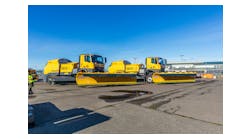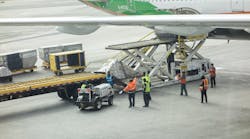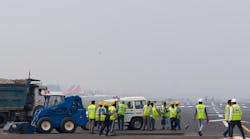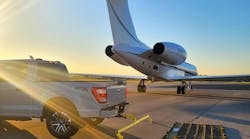The economic tally to aircraft from ground damage is astronomical no matter which trade group accident statistics you care to add up:
- According to IATA, each year aircraft suffer ground damage with worldwide losses of some $4 billion.
- The Flight Safety Foundation estimates losses from aircraft ground accidents to be $7 billion each year.
- NBAA estimates that ground damage in business aviation runs $100 million annually, including incidents during towing and ramp movement, GSE accidents and hangar damage.
At last year’s NBAA conference and trade show, Wingspan Systems Inc., Mission, KS, introduced its RampTrack Ground Accident Avoidance System (GRAAS), which helps prevent ramp and hangar accidents by tracking aircraft on the ground and issuing a warning in the event of an imminent impact with another aircraft, vehicle or person.
Essentially, the GRAAS creates an invisible “safety zone” around aircraft to protect it from damage. Whether moving or stactic, the system’s combination of sensors and related technology identifies threats in real time and provides an alert to make ramps and hangars a safer place for planes and people.
The RampTrack system comprises a powerful data processor, a dedicated Wi-Fi network and mobile sensors, including a new Spotter™ cone unit, that constantly track aircraft, ground equipment and other potential accident hazards on the ground.
Referencing a defined set of movement parameters between aircraft and potential threats, the RampTrack system measures and monitors the position of aircraft on a facility and notifies facility personnel when safety margins are exceeded. It does this accurately and reliably via the system’s advanced video processing technology, enhanced sensor capabilities and unique sensor fusion algorithms.
Combining input from video intelligence algorithms, an aircraft database and the company’s own proprietary RampTrack Rover™ multisensory units, the ground-based RampTrack Fusion Server tracks such hazards as fences, poles, GSE, other aircraft and ground personnel.
“The Fusion Server is the ‘brains of the system,” says CEO/CMO Bill Johnston, a co-founder of the company with some 25 years of experience with avionics, aircraft and safety systems marketing, “collecting input from the sensors, such as the Spotter and the small Tracker unit that can be placed in an aircraft as well as from our high-res video cameras that are placed inside the hangar.”
If there’s a risk of impact, the system issues visual and aural alert to avert an accident. In the hangar, the system monitors toolboxes, equipment and other aircraft, providing protection from “hangar rash.”
New this year is the Spotter™ cone unit, which replace fixed sensor boxes and that can move to constantly track aircraft, GSE and any potential hazards on the ground.
In addition to protecting aircraft, the GRASS also helps FBOs and airport operations by tracking aircraft by tail number, identifying arrivals and providing customer information to speed line service, generate invoices and save on line operation operations and labor costs.
Headquartered in the Kansas City area, Wingspan Systems Inc. is an aviation technology company that develops innovative ground and airborne solutions for business aviation, airline and military applications.




